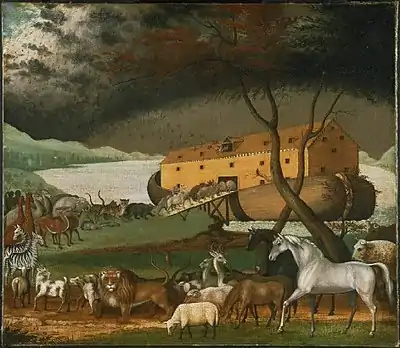Gopher wood
Gopher wood or gopherwood is a term used once in the Bible for the substance from which Noah's ark was built. Genesis 6:14 states that Noah was to build the Ark of gofer (Hebrew גפר), more commonly transliterated as gopher wood, a word not otherwise known in the Bible or in Hebrew. Although some English Bibles attempt a translation, older English translations, including the King James Version (17th century), leave it untranslated. The word is unrelated to the name of the North American animal, the gopher.[1]
- You may be looking for the tree Torreya taxifolia, sometimes called "gopher wood".

Identity
The Greek Septuagint (3rd–1st centuries BC) translated the phrase mentioning gopher wood as ἐκ ξύλων τετραγώνων (ek xúlōn tetragṓnōn), "out of squared timber".[2] Similarly, the Latin Vulgate (5th century AD) rendered it as de lignis levigatis (lævigatis, in the spelling of the Clementine Vulgate), "out of smoothed (possibly planed) wood".
The Jewish Encyclopedia believes it was most likely a translation of the Babylonian gushure iṣ erini, cedar beams, or the Assyrian giparu, reeds.[3] The Aramaic Targum Onkelos, considered by many Jews to be an authoritative translation of the Hebrew scripture, renders this word as qadros, cedar. The Syriac Peshitta translates this word as arqa, box.[4]
Many modern English translations tend to favor cypress (although otherwise the word for "cypress" in Biblical Hebrew is berosh). This was espoused (among others) by Adam Clarke, a Methodist theologian famous for his commentary on the Bible: Clarke cited the resemblance between Greek word for cypress, kuparisson and the Hebrew word gophar. Likewise the Nova Vulgata has it as de lignis cupressinis ("out of cypress wood"), in contrast to the "ligna levigata" (smoothed or planed wood) of the Clementine Vulgate.
Other suggestions include pine, cedar, fir, teak, sandalwood, ebony, wicker, juniper, acacia, boxwood, slimed bulrushes, and resinous wood.
Others, noting the physical similarity between the Hebrew letters g (gimel ג) and k (kaf כ), suggest that the word may actually be kopher, the Hebrew word meaning "pitch"; thus kopher wood would be "pitched wood". Recent suggestions have included a lamination process (to strengthen the Ark), or a now-lost type of tree, but there is no consensus.[5]
Footnotes and references
- "gopher". Online Etymology Dictionary. Retrieved 2015-11-03.
- Brenton, Sir Lancelot C. L. (1986) [1851]. The Septuagint with Apocrypha: Greek and English (Reprint ed.). Peabody, Mass., US: Hendrickson Publishers. ISBN 0-913573-44-2. OCLC 1029083225.
- Hirsch, EG; Hyvernat, H (2002). "Goper-Wood". The Jewish Encyclopedia. Retrieved 2007-06-27.
- "The Comprehensive Aramaic Lexicon". Hebrew Union College. Archived from the original on 2013-10-18. Retrieved 2013-01-30.
- Taylor, Paul (2001). "What is 'Gopher Wood'?". Eden Communications. Retrieved 2007-06-25.
External links
- Gopherwood and Construction of the Ark
- The Free Dictionary - "Gopherwood" (giving a definition of Cladrastis kentukea)